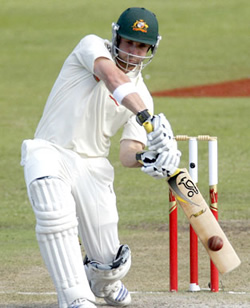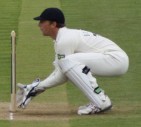Bat to the Future!
Paul Wood |
Much speculation in recent times concerns the growing band of promising young bowlers making their way in Test cricket. With a genuine lack of world class quicks currently parading their talents on the international stage, fans of the game are hopeful of glowing careers for the big pacemen such as Ishant Sharma, Morne Morkel, Stuart Broad, and Peter Siddle, to name a few. In the spin department Ajantha Mendis and Piyush Chawla have already caused problems for top batsmen with their variations, and swing bowlers Tim Southee and Ben Hilfenhaus, have both shown promise during their embryonic Test careers.
However, not willing to be overlooked are the young guns wielding the willow, the very people that must repel the attacks of the aforementioned bowlers. With a number of pitches around the world favouring the batsmen it is possible that a number of them are currently enjoying inflated and deceptive averages. Although the players looked at in more depth here certainly appear to possess the right attributes in order to reap the rewards in all conditions.
The retirement of Matthew Hayden could have left a huge void at the top of the Australian order. The big, imposing Queenslander has bullied attacks all over the world, and when he joined his pal Justin Langer in retirement, Australia mulled over a number of options available in the hope they can have half the impact ‘Haydos’ has had over the years.
What the Australian management was perhaps not expecting was a 20-year old New South Welshman to come in and make runs in a style that defies his inexperience at the highest form. Phil Hughes has strode confidently into Hayden’s boots, and has begun filling his own, with a flurry of runs in the recent series in South Africa.
Things started badly for Hughes with an impetuous and ambitious cut shot off only his fourth delivery in Test cricket when facing Dale Steyn. But boy has he hit back. In his next three innings he registered scores of 75, 115 and 160 (in the process becoming the youngest player to score two centuries in a Test), and finished the series in South Africa as the leading runscorer on either side with 415 runs at 69.16, not a bad turnaround ?
He was selected ahead of more seasoned openers, domestic run scoring machines Chris Rogers and Phil Jaques were in the equation, but it was Hughes’ form for New South Wales that really caught the eye. In the 2008/09 season he made 891 runs at an average of 74.25, this was enough to clinch him the Sheffield Shield Player of the Year award.
For Phil Hughes it is definitely a case of not how, but how many. His technique at times looks awkward at best, as he does his best to stay legside of the ball and flash at anything remotely wide of off stump. If his feet do not move into the perfect position for shot execution, then his speed of bat and hand-eye co-ordination are pretty impressive. Bowlers will formulate plans to negate his expansive strokeplay, but against Steyn and Co. he seemed to hold plenty of answers of his own.
Just over the Tasman Sea in New Zealand there is a new crop of exciting batsmen coming through. The flashy styles of Ross Taylor and Jesse Ryder have been grabbing recent headlines, understandably so following their 271 run partnership in the second Test against India. However, it is a player of a different kind that allows these guys to play freely that we will focus on. Daniel Flynn had a painful introduction into New Zealand’s Test side, when in his second appearance he received a sickening blow from England bowler Jimmy Anderson. The slow motion replays showed the impact of the ball thudding into Flynn’s grill, resulting in an immediate trip to the dentist.
Flynn lost two teeth and endured a particularly uncomfortable night suffering with nausea and vomiting. Such is his determination he wanted to bat as soon as he returned to the ground, but common sense prevailed. In the next Test a gritty 49 demonstrated the courage and fight Flynn possesses.
There is more than just courage to his game, his style is simple and avoids complication. He employs minimal trigger movements, just small steps back and across to get his feet going, and is aware of his shot limitations. He has a solid defensive look about him with his compact technique, but has also displayed the kind of positive intent which is essential since his promotion up the order to number three.
In his first knock in his new position he made a typically organised 95 against the West Indies at Dunedin, and was unfortunate to be given out, via the referral system, which adjudged him LBW off Chris Gayle. It was such a close call he rightly felt a little aggrieved.
A Test century still eludes Flynn (he has five in First-Class cricket), but if he continues to improve on the potential he has shown in his first ten Test matches, then the first ton should surely be a formality. Already averaging 41.38 in Tests, it appears the number three position for New Zealand looks in pretty safe hands.
JP Duminy, 24, is another left-hander that has already played Test innings’ that defies his inexperience at the highest level. He was thrown into his Test debut at Perth against Australia, after Ashwell Prince had to withdraw due to being struck on the thumb in the nets by Makhaya Ntini, and it appeared it was meant to be. Duminy struck the winning runs with a cover drive to register the second highest run chase of all time, and in turn brought up his first Test score of 50 for South Africa. Not a bad start.
There was even better to come from JP Duminy in the next Test at Melbourne, with a demonstration of his ice-cool temperament in a difficult situation. Australia had made 394 in their first innings, and when Duminy strode out for only his third Test innings, South Africa were wobbling at 126-4. Nathan Hauritz finally ended his innings but not until he had registered 166 crucial runs in just under seven and a half hours at the crease. South Africa reached 459, a lead of 65, and ultimately went on to win the second Test by nine wickets and complete the series victory they waited so long for.
He made his ODI debut at just 20 years old, and has established himself as one of the world’s most outstanding fielders, and he also bowls some useful off-spin.
But it is with the bat that he continues to impress. He has an elegant, composed style, that is not easily ruffled. Strong square of the wicket, Duminy also possesses the kind of cover drive that seems a pre-requisite for left-handed batsmen, and when bowlers drift onto his pads, mid-wicket can prove just as fruitful an area for his run scoring.
Duminy endured a more difficult home series against Australia passing 50 only once in six innings. He made 73 not out at Durban when Jacques Kallis (22) was the only other South African to reach double figures, another example of Duminy standing up and being counted when the more experienced players under-perform. However, you get the feeling that this was one of few series blips Duminy will have throughout, what promises to be, a very productive career.
Fighting the corner for the right-hand batsmen is a man that had made little impression on the Test scene in his first three Test matches in the trying conditions of Sri Lanka. But in one innings at Bridgetown, Barbados, Ravi Bopara transferred his outstanding domestic form onto the international scene, and gave England fans a taste of what he may be capable of producing on a more consistent basis for the Test XI.
At this point it must be said that the pitch at Bridgetown was an ideal track for batsmen trying to make their way in the game. Lacking any real pace or movement off the wicket, Bopara could basically do as he wished, barring an entertaining duel with Fidel Edwards who managed to coax some life out of the pitch and tested Bopara’s mettle with a hostile short-pitched spell. Bopara did not shy away from the challenge, and there was a degree of the compulsive hooker about him, however this was to be his day, and the gamble paid off when he hooked Jerome Taylor for a single that brought up his maiden Test century.
It was against Sri Lanka in the World Cup that Bopara first showed fans worldwide of his potential, with a gutsy 52 that took England to within a whisker of completing a highly unlikely comeback. Bopara and England came up just short that night, needing three off the last ball Bopara was bowled by Dilhara Fernando, a superb effort nonetheless.
Bopara has the sub-continental traits about him. His wristiness through the leg side is a joy to behold, but he is not restricted to this area. Equally adept at working the ball through the gaps on the off-side, he certainly possesses strokes all round the wicket.
If Hughes, Flynn and Duminy are currently assured of their places in their respective national sides, then Bopara still has some work to do. Left out following his century for tactical purposes (England opted for an extra bowler in the hope they could force a positive result in the next Test), England’s only position in the batting order up for grabs (should all players retain their fitness) is the number three spot, and after Owais Shah struggled to nail down his place, it all seems set for Michael Vaughan to return in time for the Ashes series. So the Essex man may be forced to wait to regain a place in the side, but given an extended run will be very hard to shift.
Converting potential into actual consistent world class performances is far from easy. There have been numerous batsmen over the years that seem to have the world at their very talented feet, only to find that maybe they weren’t the real deal everybody predicted. There is no guarantee these four players will be any different, which is why we should simply enjoy watching them at every conceivable opportunity.




Aussie need to have hopes in the side keep hussey this is my side Aussie for the ashes just the 11 1Phil Hughes 2Simon katich Ricky ponting3 4 mike hussey 5 Micheal Clarke 6 James hopes 7 brad haddin 8 Mitchell Johnson 9 jason krezia 10 geeves 11 siddle
Comment by Nick | 12:00am BST 6 April 2009